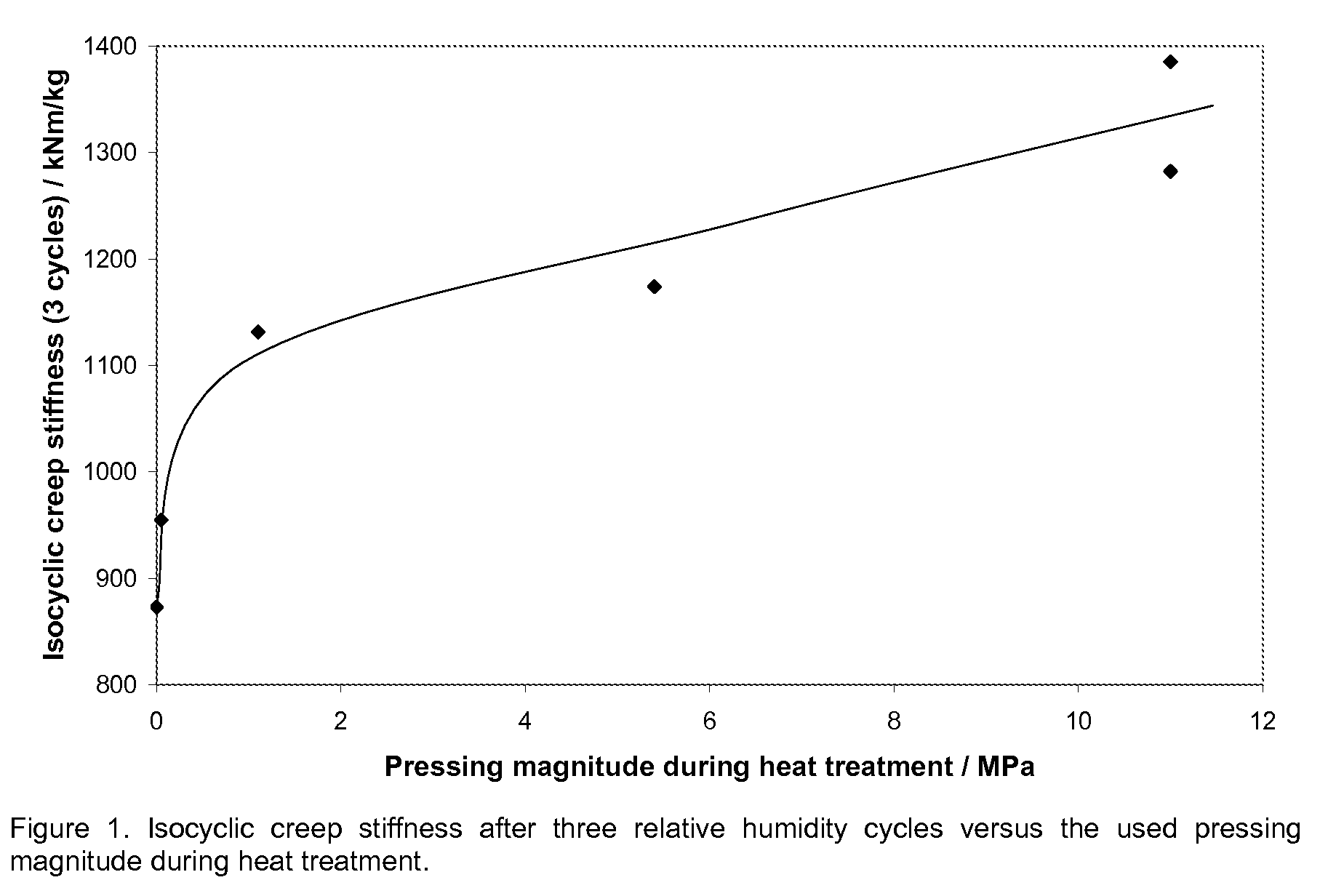Method for manufacturing a composite material having reduced mechanosorptive creep, the composite material, use of the method and the composite material
a composite material and mechanosorptive creep technology, applied in the field of manufacturing a composite material having reduced mechanosorptive creep, the composite material, the use of the method and the composite material, can solve the problems of creep risk, rigidity, and stability of composite materials containing both lignocellulosic materials and plastic materials, and achieve the effect of reducing mechanosorptive creep
- Summary
- Abstract
- Description
- Claims
- Application Information
AI Technical Summary
Problems solved by technology
Method used
Image
Examples
regarding example 1
[0056]A laboratory made sulfate softwood pulp (spruce, kappa 34) was used. PLA fibers (PL01 5 mm, 1.7 dtex) where purchased from Unitika, Japan.
[0057]Sulphate fibre / PLA sheets were produced using a dynamic sheet former. The drum rotated 1500 min−1 and the pressure was 2.8 bar. The consistency of fibre suspensions was 1%. The PLA fibers were suspended in water and added to the pulp suspension immediately before sheet formation. After formation, sheets were roll pressed twice, first at 1 bar and a second time at 5 bar pressure. The sheets were dried under restraint at 100° C. for 16 minutes and stored in plastic bags before use. Grammage of produced sheets was 100 g / m2. Sheets containing 0, 5, 25 and 40 wt % PLA were produced. Two separate sets of sheet were produced (experiment one and two), see table 1.
[0058]From the sheets, pieces (13*21 cm) were cut and pressed at 7 MPA (dial value) at 175° C. using a Servitec Polystat 200T. In order to prevent the sample from sticking to the heat...
regarding example 2
[0063]Experiment 2 was performed in order to verify the usefulness of wet formed composite material in injection moulding.
[0064]The wet compounded material was made using unbleached spruce sulphate pulp and PLA (PL01, 5 mm, 1.7 dtex, Unitika, Japan). Either pulp fibres or PLA fibres were beaten together for 4 000 revs, 4% consistency, and thereafter dried in room temperature; or PLA fibres and pulp fibres were beaten separately and mixed afterwards. The material was subsequently either dried and torn into small pieces by hand or formed into wet laid mats. The mats were also dried prior to use.
[0065]Two different qualities were made; 40% PLA contents and 70% PLA contents.
[0066]The 70% PLA content pulp was extruded to granulates in a ZSK 25 WLE twin screw extruder (Krupp Werner & Pfleider, Dinkelsbühl, Germany). The extruder held a temperature of 190° C. and a screw velocity of 350 rpm. Two different processing lengths were tried out. For granule1 about ⅖ of the screw was used while f...
regarding example 3
[0069]Standard lab sheets were prepared from a mixture of 80% by weight industrially made softwood kraft pulp (kappa 42) and 20% by weight PLA fibers (PL01 5 mm, 1.7 dtex) (Unitika, Japan) according to ISO 5269-1. The prepared sheets were heat treated at 180° C.
[0070]Different constant magnitudes of pressure were applied to the sheets during the heat treatment. Mechanosorptive creep experiments were performed at a temperature of 23° C. and an ambient relative humidity that was cycled between 50% and 90%. The experimental data was used to determine the isocyclic creep stiffness (Panek et. al, 2004) of the sheets. The results (FIG. 1) clearly show that the isocyclic creep stiffness of the sheets was enhanced by increasing the pressure during the heat treatment. The results further show that a lower threshold in pressure had to be exceeded during the heat treatment in order to achieve a substantial positive effect of the PLA fibres addition on the mechanosorptive creep properties of th...
PUM
| Property | Measurement | Unit |
|---|---|---|
| pressure | aaaaa | aaaaa |
| gauge length | aaaaa | aaaaa |
| RH | aaaaa | aaaaa |
Abstract
Description
Claims
Application Information
 Login to View More
Login to View More - R&D
- Intellectual Property
- Life Sciences
- Materials
- Tech Scout
- Unparalleled Data Quality
- Higher Quality Content
- 60% Fewer Hallucinations
Browse by: Latest US Patents, China's latest patents, Technical Efficacy Thesaurus, Application Domain, Technology Topic, Popular Technical Reports.
© 2025 PatSnap. All rights reserved.Legal|Privacy policy|Modern Slavery Act Transparency Statement|Sitemap|About US| Contact US: help@patsnap.com

